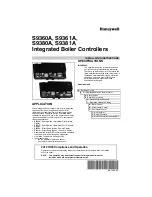
80
EN
Cod. 3542B230 - Rev. 00 - 02/2022
OMNIA S HYBRID H 3.2
Residual Risks
The machines has been designed with a view to reducing the risks to persons and the environment in which it is installed, to the minimum. To eliminate residual risks,
it is therefore advisable to become as familiar as possible with the machine in order to avoid accidents that could cause injuries to persons and/or damage to property.
a. Access to the unit
Only qualified persons who are familiar with this type of machine and who are equipped with the necessary safety protections (footwear, gloves, helmet, etc.) may
be allowed to access the machine. Moreover, in order to operate, these persons must have been authorized by the owner of the machine and be recognized by the
actual Manufacturer.
b. Elements of risk
The machine has been designed and built so as not to create any condition of risk. However, residual risks are impossible to eliminate during the designing phase and
are therefore listed in the following table along with the instructions about how to neutralize them.
Indoor unit residual risks
Part in question
Residual risk hazard
Mode
Precautions
Refrigeration and hydraulic pipes
Burns
Contact with pipes
Avoid contact by wearing protective gloves
Refrigerant pipes, plate heat exchanger.
Explosion
Excessive pressure
Switch off the machine, check the high pressure switch and the
safety valve, fans and capacitor
Refrigerant pipes
Ice burns
Refrigerant leakage
Do not pull the pipes
Electric cables, metal parts
Electrocution, serious burns
Insulation of faulty cable, live metal parts
Suitable electric protection (correct unit grounding)
General rules for maintenance
The maintenance is extremely important for the functioning of the system and the regular working of the unit over time.
In accordance with the European Regulation EC 303/2008 , it should be noted that companies and engineers in maintenance , repair, leak testing and recovery /
recycle refrigerant gases should be CERTIFIED in accordance with local regulations.
Maintenance must be performed in compliance with the safety rules and tips given in the manual supplied with the unit.
Routine maintenance helps maintain unit efficiency, reduce the rate of deterioration which each device is subject in time and gather information and data to understand
the efficiency of the unit and prevent failures.
For extraordinary maintenance or in case you need service , contact only to a specialized service center approved by the manufacturer and use original spare parts.
In accordance with the European Regulation EC 1516/2007 it is necessary to prepare a “equipment record”.
Provide a databook (not supplied), however, that allows you to keep track of interventions made on the unit; in this way it will be easier to properly program the various
interventions and will facilitate troubleshooting, if required.
Recorded on the databook: date, type of intervention performed, description of the intervention, measurements, reported anomalies, alarms recorded in the alarm
history, etc.
13.1 Access to internal components
WARNING
Some components inside the unit can reach temperatures high enough to inflict serious burns. Before carrying out
any operation, wait until these components have cooled down or, alternatively, wear suitable gloves.
To access the internal components, see “7.9.1 Opening the front panel" on page 42.
WARNING
The casing also acts as a sealed chamber in this appliance. After every operation which involves opening the boiler,
check correct assembly and tightness of the front panel.
Proceed in reverse order to reassemble the front panel. Make sure that it is correctly secured to the upper fastenings and fully resting in the sides. The head of screw
“A”, once tightened, should not be below the lower profile (see “fig. 28 - assembly with bottom screws" on page 42).
To access the internal components after removing the front panel, you must remove the two fastening screws of the heat pump electric box, then turn it first to the left
and afterwards, turn the expansion vessel to the right (fig. 49). It is then possible to turn the boiler electric box downwards after removing the two lower screws (see
“fig. 59 -" on page 85).









































